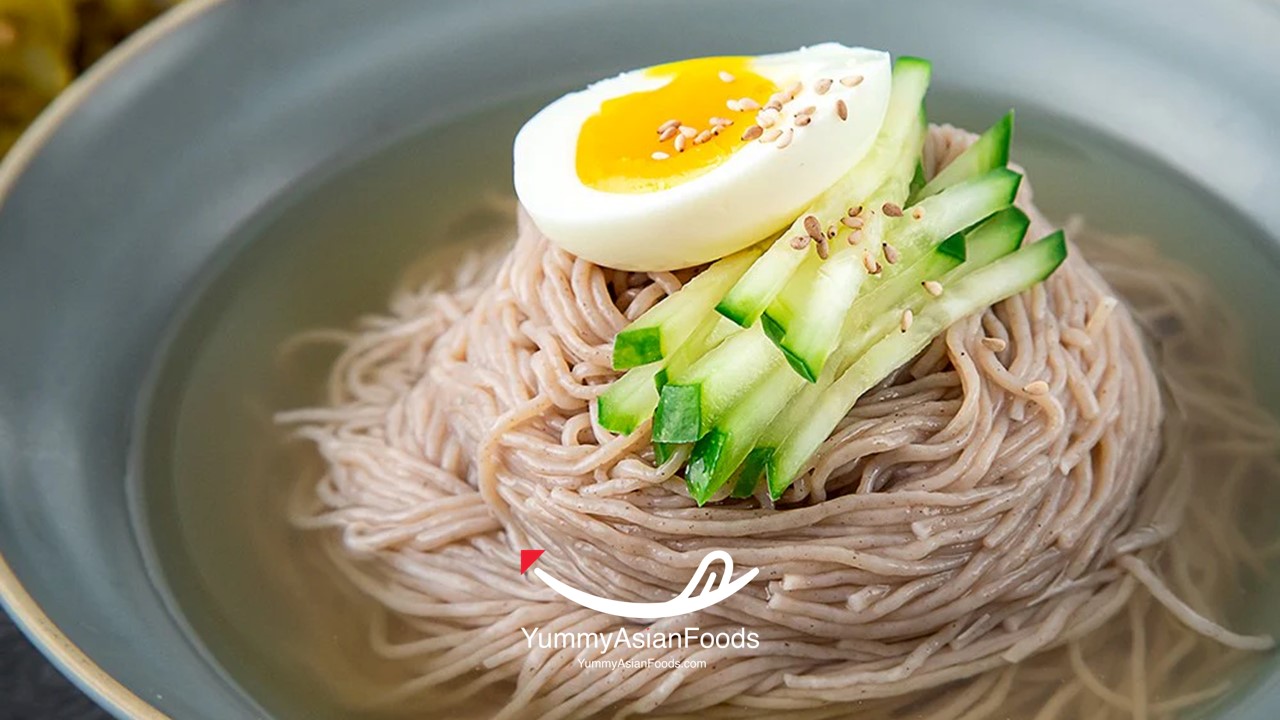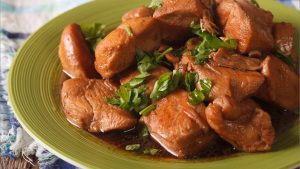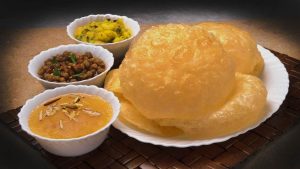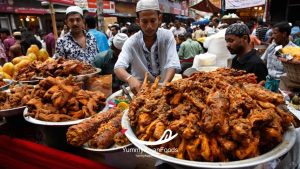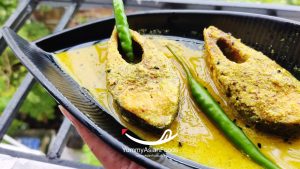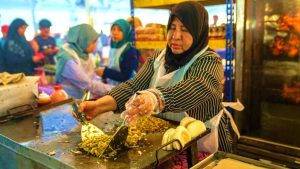Table of Contents
ToggleStep into the savory world of Korean cuisine with a steaming bowl of traditional noodle soup that promises to warm both body and soul. From the bustling streets of Seoul to the serene countryside, Korean noodle soup recipes have been cherished for generations as a comforting staple in Korean households. Each spoonful is a symphony of flavors, blending rich broth, chewy noodles, and an array of tantalizing toppings that dance on your taste buds. Get ready to embark on a culinary adventure as we explore nine delectable Korean noodle soup recipes that are sure to leave you slurping for more. So grab your chopsticks and prepare to dive into the enticing world of 11 traditional Korean noodle soup dishes, where every spoonful tells a tale of heritage, flavor, and pure satisfaction.
What are the Popular Korean Noodle Soup Dishes?
Korean cuisine is renowned for its diverse flavors and rich culinary heritage, with noodle soup dishes occupying a special place in the hearts of many food enthusiasts. One such popular dish is Japchae, a sweet potato glass noodle soup that combines a medley of colorful vegetables and savory seasoned meat for a harmonious taste explosion. Moving on to another crowd favorite, Kalguksu features handmade knife-cut noodles swimming in a hearty broth alongside an assortment of fresh ingredients like clams or kimchi.
Delving deeper into the world of Korean soups, we encounter the tantalizing Yukgaejang, which packs a spicy punch with tender shredded beef and vibrant vegetables simmered to perfection in a fiery red broth. Fans of seafood can indulge in the delicious flavors of Jjamppong, a spicy seafood noodle soup brimming with shrimp, mussels, and squid enveloped in a robust broth laden with gochugaru (Korean chili flakes) for that extra kick. These popular Korean noodle soup dishes showcase the intricate balance of flavors and textures that define this beloved culinary tradition.
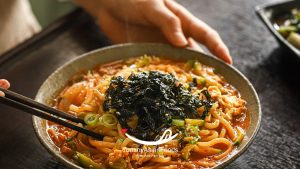
Here are 11 Traditional Korean Noodle Soup Dishes
1. Janchi Guksu (잔치국수) Korean Noodle Soup
Janchi Guksu, a beloved Korean noodle soup dish, brings together the simplicity of somyeon wheat noodles and the flavorsome depth of anchovy or beef broth. The interplay between the delicate noodles and savory broth creates a harmonious symphony of textures and tastes that is sure to delight the palate. What sets Janchi Guksu apart is its ability to be both comforting and refreshing at the same time, making it a perfect choice for any occasion.
The varying ways in which Janchi Guksu can be flavored add an intriguing element to this classic dish. From subtle hints of anchovy enhancing the umami notes to bold beef broth infusing richness, each variation offers a unique dining experience. The beauty lies in its adaptability. Whether enjoyed as a light meal on a warm day or as a heartwarming bowl on a chilly evening, Janchi Guksu never fails to satisfy.
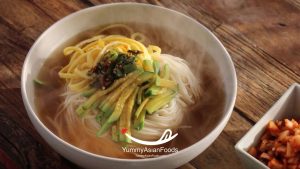
2. Gamja-ongsimi-guk (감자옹심이국) Korean Noodle Soup
One of South Korea’s hidden culinary gems, Gamja-ongsimi-guk, also known as Korean potato dumpling soup, is a delightful twist on traditional noodle soups. The star of this dish is the potato dumplings, which add a hearty and comforting element to the light broth. Unlike other noodle soups, the potato dumplings give this soup a unique texture and flavor profile that sets it apart.
The simplicity of the ingredients allows the subtle flavors to shine through in each spoonful. The soft and pillowy potato dumplings soak up the savory broth, creating a harmonious balance of flavors. This dish embodies the essence of Korean comfort food—simple yet satisfying. Gamja-ongsimi-guk is a must-try for those looking to explore authentic Korean cuisine beyond the usual suspects.
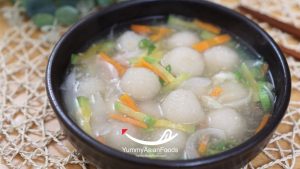
3. Memil Guksu (들기름 막국수) Korean Noodle Soup
Memil Guksu, known for its refreshing and light flavors, offers a unique twist to the traditional South Korean noodle soup experience. Made from buckwheat noodles, this dish is not only visually appealing but also packs a flavorful punch. The star of Memil Guksu lies in the accompanying dipping sauce, which strikes a perfect balance between savory and tangy notes, elevating each slurp of noodles to an unforgettable culinary delight.
What sets Memil Guksu apart is its simplicity and purity of taste, showcasing the essence of Korean cuisine through minimalistic yet powerful flavors. This cold noodle soup is perfect for cooling down on hot summer days or as a light and satisfying meal option any time of the year. Embrace the art of dipping each strand of chewy noodles into the aromatic sauce, allowing your taste buds to dance with joy at every bite. With Memil Guksu, prepare your palate for a delightful journey that celebrates the beauty of simplicity in Korean culinary traditions.
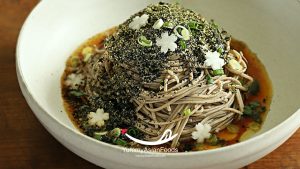
4. Bibim Guksu (비빔국수) Cold Korean Noodle Soup
Imagine a refreshing bowl of Bibim Guksu on a scorching summer day, the cold noodles mixed with tangy kimchi delivering an explosion of flavors in every bite. This dish is not just a simple noodle soup; it’s a harmonious blend of textures and tastes that leaves your taste buds tingling. The fermented kimchi adds depth and complexity to the broth, elevating it from ordinary to extraordinary.
The fiery kick of spiciness combined with the coolness of the noodles creates a delightful contrast that keeps you coming back for more. Bibim Guksu is not just a meal; it’s an experience that showcases the innovative and bold flavors of Korean cuisine. With each spoonful, you’ll discover new layers of flavor that will have you hooked from the first slurp to the last satisfying bite.
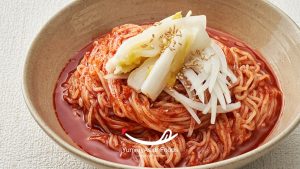
5. Sujebi (수제비) Korean Noodle Soup
Sujebi, a beloved Korean noodle soup dish, boasts a comforting combination of hand-pulled wheat noodles and flavorful broth. The art of pulling the noodles by hand infuses this soup with a unique texture that sets it apart from other noodle dishes. Each slurp brings a touch of homemade goodness to the palate, showcasing the skill and dedication required to create such a delicacy.
The beauty of Sujebi lies in its simplicity. While it may seem like just noodles in broth at first glance, the depth of flavor in the traditional broth elevates this dish to new heights. It’s not just about sustenance; Sujebi embodies Korean culinary heritage and warmth in each bowl, inviting you to savor every spoonful with appreciation for its humble origins and rich taste profile.
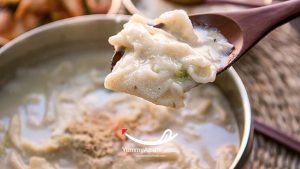
6. Kongguksu (콩국수) Korean Noodle Soup
Kongguksu is a South Korean summer classic that boasts a unique combination of noodles and a refreshing cold soy milk broth. The simplicity of this dish may fool you, but its flavor profile is far from basic. While it may seem unusual to have noodles with a milky broth, the smoothness of the soy milk perfectly complements the chewy texture of the noodles, creating a delicate balance that tantalizes the taste buds.
What sets Kongguksu apart from other Korean noodle soups is its light yet satisfying nature. Unlike its richer counterparts, this soup offers a lighter alternative without compromising on taste. The use of soy milk as the base adds a creamy depth to the dish, making it stand out amidst Korea’s diverse noodle soup offerings. Whether you’re looking for a cool and comforting meal during hot summer days or simply craving something different yet delicious, Kongguksu delivers a memorable dining experience that is sure to leave you craving more.
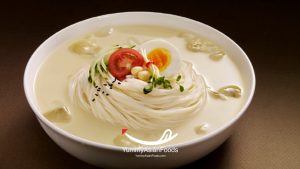
7. Jjamppong (Jjampong 짬뽕) Spicy Seafood Korean Noodle Soup
Jjamppong, a fiery and flavorsome South Korean noodle soup, is a sensory delight that excites the taste buds with its rich seafood broth and complex blend of spices. This dish brings together an array of ocean treasures like shrimp, mussels, squid, and vegetables in a steaming bowl of goodness.
What sets Jjamppong apart is not just its bold spiciness but also the depth of flavor derived from the combination of ingredients. Each slurp reveals a burst of umami from the seafood and a satisfying heat from the red chili pepper flakes. Soothing yet invigorating, Jjamppong is a comforting indulgence for those craving a uniquely vibrant culinary experience.
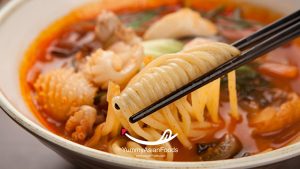
8. Mul Naengmyeon or Mul Naengmyun (물냉면) Cold Korean Noodle Soup
The refreshing Mul Naengmyeon, also known as Cold Korean Noodle Soup, offers a delightful taste of Korean culinary tradition. This chilled dish features chewy buckwheat noodles served in a tangy cold broth made from beef or dongchimi, a type of radish kimchi. The addition of hard-boiled eggs, cucumber slices, and vinegar adds layers of flavor and texture to this unique soup.
A perfect dish for hot summer days, Mul Naengmyeon, is not only delicious but also packed with health benefits. The cold temperature of the soup can help cool the body down during warm weather, while the lean protein from the beef and nutrients from the vegetables make it a nutritious option. With its combination of flavors and textures, Mul Naengmyeon is sure to tantalize your taste buds and leave you craving more of this Korean noodle soup delight.
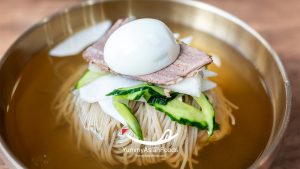
9. Kalguksu (칼국수) Korean Noodle Soup
Kalguksu, a traditional South Korean noodle soup, is a dish that embodies the essence of comfort and tradition. The complexity of flavors in this humble bowl of noodles reflects the rich culinary heritage of Korea. Handmade wheat flour and egg noodles swim gracefully in a flavorful broth infused with the oceanic notes of shellfish, dried anchovies, and kelp.
This bowl of Kalguksu is more than just a meal; it’s a representation of meticulous craftsmanship and culinary mastery. The delicate balance between the hearty noodles and umami-rich broth creates a symphony for the taste buds. Each spoonful is an invitation to explore the depths of Korean cuisine, one slurp at a time. Indulge in Kalguksu for an authentic dining experience that will transport you to the bustling streets of Seoul with every savory sip.
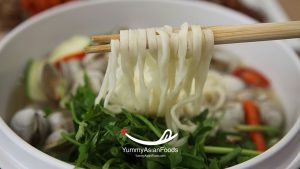
10. Dak Kalguksu (닭 칼국수) Korean Noodle Soup
Dak Kalguksu, a delightful Korean noodle soup dish that seamlessly combines the comforting flavors of chicken and the satisfying texture of knife-cut noodles. This fusion creates a hearty and soul-warming broth that is perfect for any time of year. The thin and flat knife-cut noodles absorb the rich flavors of the chicken broth, making each spoonful a burst of savory goodness.
The Dak Kalguksu’s simplicity in ingredients highlights the importance of quality over quantity in Korean cuisine. It showcases how humble ingredients like chicken and handmade noodles can come together to create a bowl full of complex flavors and textures. The delicate balance between the lightness of the broth and the heartiness of the noodles makes Dak Kalguksu a versatile dish that can be enjoyed as a light lunch or as a warm dinner option.
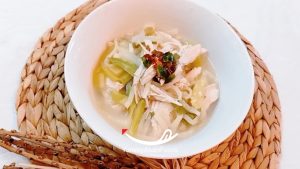
11. Naengmyeon (냉면) Korean Noodle Soup
Picture this: a refreshing bowl of Naengmyeon, the quintessential Korean noodle soup perfect for beating the summer heat. The star of this dish is its unique noodles, which are made from a combination of buckwheat and potato or sweet potato starch. What sets Naengmyeon apart is its cold temperature and tangy broth, creating a delightful contrast that surprises your taste buds with every slurp.
But there’s more to Naengmyeon than just its chilled nature; it also boasts a delicious array of toppings like thinly sliced cucumber, pickled radish, and hard-boiled egg—all adding layers of texture and flavor to each bite. As you savor each mouthful, the chewy noodles glide effortlessly across your palate while the savory broth dances with hints of sweetness and spice. So, if you’re looking to experience a symphony of flavors in one bowl, make sure to add Naengmyeon to your list of must-try Korean noodle soup dishes!
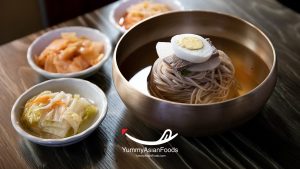
History of Korean Noodle Soup Dishes
South Korean noodle soup dishes have a rich history that dates back centuries, reflecting the cultural influences and innovations that have shaped Korean cuisine. Janchi guksu, for example, is a traditional noodle soup often served at celebratory events like weddings and birthdays. Its simplicity in preparation highlights the emphasis on fresh ingredients and clean flavors in Korean cooking.
Moving onto kalguksu, a comforting noodle soup made with handmade knife-cut noodles, showcases the meticulous artistry involved in crafting this dish. The chewy texture of the noodles combined with the hearty broth makes it a beloved comfort food among Koreans. Each sip of kalguksu transports you to traditional Korean kitchens, where recipes are passed down through generations, preserving culinary traditions for future enjoyment.
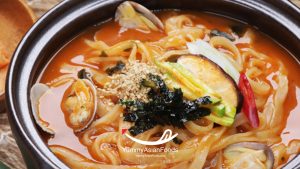
Hot or Cold Korean Noodle Soup Dishes
For those who enjoy a little spicy kick in their meals, hot South Korean noodle soups are the perfect choice. Dishes like Kimchi Jjigae Noodles and Spicy Ramyun Noodles not only warm you up but also tantalize your taste buds with their bold flavors. The heat from the spices in these soups adds a dynamic element to the overall dining experience, making each slurp more exciting than the last.
In contrast, cold Korean noodle soups offer a refreshing and light alternative that is ideal for beating the summer heat. Naengmyeon, made of chewy buckwheat noodles in an icy-cold broth, is a classic dish loved by many Koreans during hot weather. The combination of coolness from the chilled soup and textures of vegetables and protein toppings create a unique harmony that makes cold noodle soups a delightful culinary experience worth exploring.
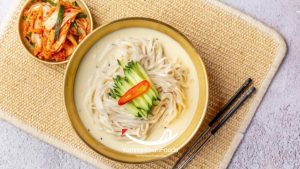
Ingredients Commonly Used in Korean Noodle Soup Dishes
A key ingredient that sets South Korean noodle soup dishes apart is gochujang, a fermented red chili paste that brings depth and complexity to the broth. This versatile condiment adds a spicy kick along with a touch of sweetness and umami, creating a harmonious flavor profile that tantalizes the taste buds.
Another essential component is dashi, a Japanese-style stock made from kombu (dried kelp) and dried anchovies, or bonito flakes. While not traditionally Korean, dashi has found its way into many Korean noodle soups, contributing a savory undertone that enhances the overall richness of the dish.
Additionally, various vegetables, like napa cabbage, radish, and mushrooms, are commonly used in Korean noodle soup dishes to add freshness and texture. These ingredients not only provide nutritional benefits but also complement the heartiness of the broth, creating a well-balanced and satisfying meal experience for any food enthusiast looking to explore authentic Korean cuisine through its diverse range of noodle soup offerings.
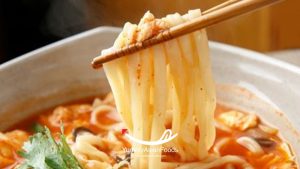
Types of Noodles for a Korean Noodle Soup
When it comes to South Korean noodle soups, the types of noodles used play a crucial role in enhancing the overall experience of the dish. One popular choice is Kalguksu, which features handmade knife-cut wheat flour noodles that have a uniquely chewy texture, perfect for soaking up the flavorful broth. Another traditional option is Naengmyeon, cold buckwheat or sweet potato starch noodles served in a chilled, clear broth—ideal for hot summer days. For those looking for something heartier and thicker, Janchi Guksu offers thin wheat flour noodles in a rich anchovy or beef-based broth.
In addition to these classics, South Korean noodle soups also incorporate rice cakes known as Tteok into dishes like Tteokguk. The soft and chewy rice cakes add a delightful texture to the soup, providing a satisfying bite with every spoonful. For those seeking a gluten-free option, Memil Guksu uses buckwheat noodles that are both nutritious and delicious. These diverse types of noodles not only add variety but also contribute unique flavors and textures to each Korean noodle soup, making them an essential component of this beloved cuisine.
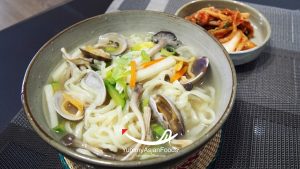
Tips for Enhancing the Flavor of a Korean Noodle Soup Dish
To elevate the flavor of your South Korean noodle soup dish, consider incorporating a variety of toppings and condiments. Traditional options like kimchi, sliced green onions, and fried garlic can add depth and complexity to the broth. For a spicy kick, try adding a dollop of gochujang or gochugaru for that classic Korean heat.
Additionally, experimenting with different types of noodles can bring a new dimension to your soup. While udon noodles are commonly used in dishes like Japchae Guksu, trying variations such as sweet potato glass noodles or knife-cut noodles can offer unique textures and flavors. Don’t be afraid to get creative with your ingredients; adding seafood like shrimp or mussels can introduce a burst of freshness to your soup that will surprise and delight your taste buds.
Health Benefits of Korean Noodle Soup Dishes
One of the captivating aspects of South Korean noodle soup dishes lies in their health benefits. Featuring a variety of nutritious ingredients, such as vegetables, lean proteins, and savory broths, these soups offer a balanced meal that can contribute to overall well-being. For example, the classic japchae noodles are often stir-fried with an array of colorful vegetables, providing essential vitamins and minerals for a boost in immunity and vitality.
Another notable dish is kalguksu, which features hand-cut noodles immersed in a hearty broth along with protein-rich ingredients like chicken or seafood. This combination not only offers a filling meal but also supplies essential nutrients for muscle repair and energy replenishment. Additionally, the inclusion of garlic and ginger in many Korean noodle soup recipes provides added health benefits such as anti-inflammatory properties and immune system support.
Last Sip: Korean Noodle Soup Dishes that are Soup-er Delicious!
As we come to a close on our exploration of authentic Korean noodle soup dishes, it’s clear that this culinary journey has been nothing short of soul-warming and delicious. From the rich and comforting flavors of jjamppong to the refreshing and spicy kick of bibim guksu, each bowl tells a unique story steeped in tradition and flavor. The simplicity yet complexity of these dishes showcases the essence of South Korean cuisine: bold flavors, diverse textures, and a deep-rooted passion for food that transcends borders.
In a world where fast food often reigns supreme, Korean noodle soup dishes serve as a reminder of the power of slow cooking and savoring each bite. As you slurp your way through these soups, you not only nourish your body but also feed your soul with the warmth and comfort only a bowl of homemade goodness can provide. So next time you find yourself craving something hearty and fulfilling, consider diving into the world of Korean noodle soup dishes for an unforgettable culinary experience that will leave you wanting more.


